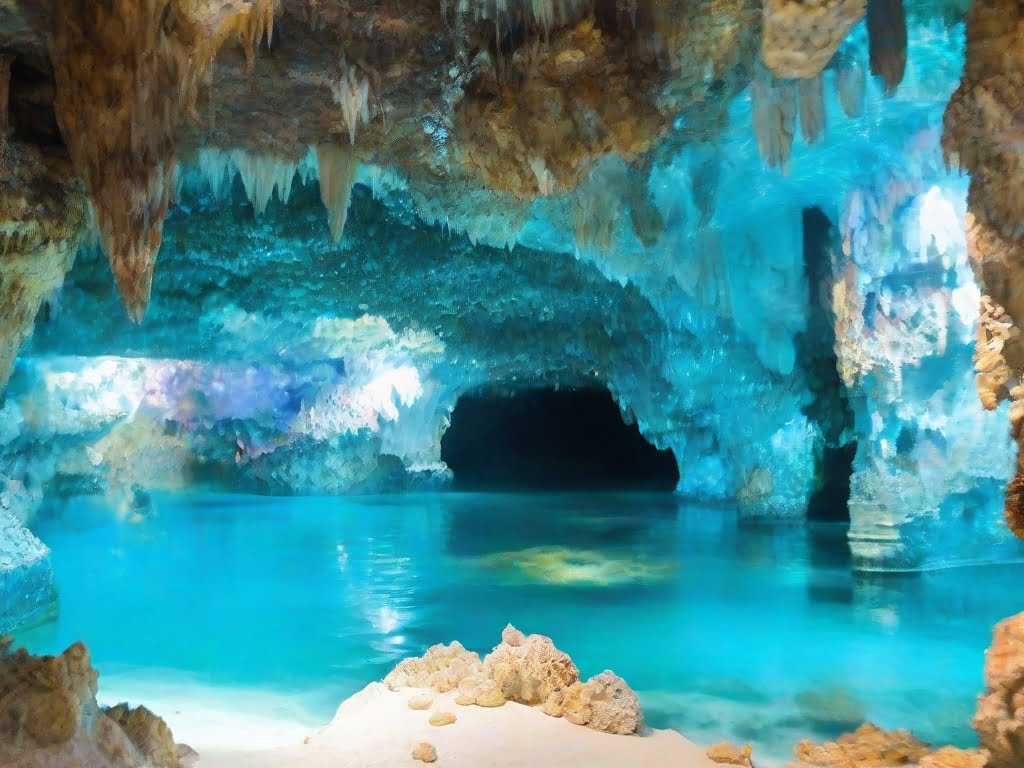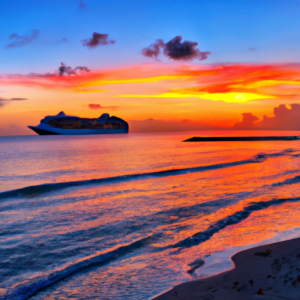Picture yourself stepping into a hidden world, far removed from the hustle and bustle of everyday life. As you descend deeper into the earth, the air turns cool and crisp, and an electric sense of excitement fills your lungs. Welcome to the mesmerizing realm of the Crystal Caves, where stalactites hang like fragile chandeliers and the crystal-clear waters below shimmer with an ethereal beauty. Join us on a journey of discovery as we delve into this hidden wonder, unlocking its secrets and marveling at the wonders that lie beneath the surface.
Table of Contents
ToggleFormation of Crystal Caves
Crystal caves are formed through various geological processes over millions of years. These caves are typically found in limestone or other soluble rocks, as they are more prone to erosion. Rainwater, which is naturally slightly acidic, seeps into the ground and gradually dissolves the rock, creating openings and cavities underground. Over time, these openings become larger and form caves.
Deposition of minerals is another crucial factor in the formation of crystal caves. As water drips through the cave ceilings, it carries dissolved minerals with it. When the water evaporates or drips onto the cave floor, the minerals are left behind and gradually accumulate. This process leads to the growth of beautiful stalactites and stalagmites, which are formed from the minerals found in the cave walls and floors.
The role of water in cave formation cannot be underestimated. Water flowing through the caves over extended periods of time helps to shape the unique features found within crystal caves, such as underground rivers, lakes, and breathtaking waterfalls. The constant movement and flow of water also contribute to the stunning formations and cascades of crystals that are often found in these caves.
World’s Most Magnificent Crystal Caves
The world is home to several extraordinary crystal caves that are revered for their unmatched beauty. One of the most famous crystal caves is the Cave of the Crystals in Mexico. This cave is renowned for its gigantic gypsum crystals, some of which reach up to 39 feet in length. The Reed Flute Cave in China is another remarkable crystal cave, with its stunning stalactites illuminated by colorful lights. The Naica Mine Ice Caves in Mexico showcase a unique combination of ice formations and crystals, creating an otherworldly landscape. Eisriesenwelt Ice Cave in Austria is a marvel, featuring a labyrinth of frozen formations that mesmerize visitors. The Waitomo Glowworm Caves in New Zealand offer a magical experience, with walls adorned by glowworms that create a stellar display. Lastly, the Cave of Wonders in Brazil is a hidden gem, known for its impressive crystal formations and underground rivers.
Exploring Crystal Caves: A Unique Adventure
Exploring crystal caves is an exhilarating and unique adventure, but it is essential to take necessary safety precautions. It is crucial to go on professional guided tours, as they have the expertise and knowledge to navigate through the intricate cave systems safely. These tours often provide specialized cave exploration gear, such as helmets, headlamps, and sturdy footwear, ensuring visitors are well-equipped for the journey ahead.
Crystal cave exploration can also pose physical challenges, as some caves may require climbing, crawling through narrow passages, or enduring long walks. It is important to be physically fit and prepared for the physical exertion that may be involved. Additionally, visiting crystal caves can be an emotionally and psychologically captivating experience. The darkness, vastness, and solitude of the underground world may evoke a mix of wonder, awe, and even a sense of vulnerability. It is important for visitors to be prepared for the emotional impact of such a unique adventure.
Crystal Caves as Natural Treasures
Crystal caves are not only visually stunning, but they also hold great scientific and ecological significance. Scientists flock to these caves to conduct research on the formations, the geological processes at play, and the unique life forms that have adapted to the cave environment. These studies contribute to our understanding of geology, ecology, and the fragile balance of our planet’s ecosystems.
The ecological significance of crystal caves cannot be overlooked. These underground ecosystems support a diverse array of cave-dwelling species that have adapted to thrive in the darkness. Some crystal caves provide shelter to rare and endemic species that are found nowhere else on Earth. Preserving and protecting these caves is crucial for the conservation of these unique and fragile ecosystems.
Efforts are being made around the world to preserve crystal caves and their delicate formations. Governments, conservation organizations, and local communities recognize the importance of these natural treasures and strive to safeguard them for future generations. This includes implementing strict regulations on cave visitation, limiting the number of visitors, and enforcing responsible tourism practices.
Unique Features of Crystal Caves
Crystal caves exhibit a range of unique features that make them truly awe-inspiring. One of the most captivating features of these caves is the abundance of stalactite formations. Stalactites hang from the cave ceilings like frozen mineral icicles, while stalagmites rise from the floor, formed by the constant dripping and accumulation of mineral-rich water.
Crystal caves are also known for their glistening crystal ceilings, which give the impression of being inside a crystalline palace. These crystal ceilings are formed by the slow deposition of minerals over time, creating a shimmering spectacle that captivates visitors.
Underground rivers and lakes are another fascinating feature of crystal caves. This flowing water adds an element of movement and life to the otherwise still underground environment. The rivers and lakes may vary in size and depth, and they often play a vital role in the formation and growth of the caves.
Crystal caves are home to a wide variety of rare and unique cave-dwelling species. These creatures have adapted to the darkness and lack of sunlight, showcasing extraordinary evolutionary traits. From blind fish to cave crickets, these species have evolved to thrive in their underground habitats.
Phenomenal light shows are yet another astonishing feature of crystal caves. Many caves are illuminated by natural sunlight streaming through openings or artificial lights strategically placed to enhance the beauty of the formations. This interplay between light and crystal formations creates a mesmerizing visual spectacle that leaves a lasting impression on visitors.
Crystal Caves Around the World
Crystal caves can be found on every continent, each offering its own unique wonders to explore. In Europe, countries such as France, Spain, and Romania boast breathtaking crystal caves. Asia, specifically China and Vietnam, is home to numerous magnificent crystal caves, from the Reed Flute Cave to Hang Son Doong, the world’s largest known cave. North America is blessed with a variety of crystal caves, such as the aforementioned Cave of the Crystals and the Mammoth Cave in the United States. South America is not to be overlooked, with Brazil’s Cave of Wonders being a prime example of the continent’s crystal cave treasures. Africa and Oceania also offer their fair share of extraordinary crystal caves that are waiting to be discovered.
Challenges in Crystal Cave Exploration
Exploring crystal caves is not without its challenges. Accessibility and location play a significant role in the exploration of these underground wonders. Many crystal caves are located in remote and hard-to-reach areas, requiring skilled mountaineering or hiking techniques to access them. This adds to the sense of adventure and exclusivity, but also demands careful planning and preparation.
Extreme temperatures and humidity levels can pose significant challenges in crystal cave exploration. Some caves are prone to scorching heat, while others can be freezing cold. Additionally, the humid environment inside the caves can make the air feel heavy and difficult to breathe. Explorers must be prepared to cope with these extreme conditions.
Limited oxygen levels can also be a concern in crystal caves. As caves are enclosed spaces, the oxygen supply may be limited, especially in deep or extensive cave systems. Proper ventilation and monitoring of oxygen levels are crucial to ensure the safety of visitors and explorers.
Navigating through narrow passages and tight spaces can be a daunting task for cave explorers. Crystal caves often have intricate networks of tunnels and passages that require agility and flexibility to navigate. It is essential to have proper training and experience or be guided by professionals to safely maneuver through these challenging areas.
Detecting unstable cave structures is another challenge in crystal cave exploration. Over time, the cave formations and structures may become unstable, posing potential risks to visitors. Experienced guides and experts are trained to recognize signs of instability, ensuring that visitors can explore the caves safely.
Adventure Tourism and Crystal Caves
Adventure tourism has witnessed a surge in popularity in recent years, and crystal caves offer a unique and thrilling experience for adventure seekers. Exploring these caves provides an adrenaline rush like no other, as visitors embark on a journey into the unknown depths of the Earth.
Thrill-seeking activities in crystal caves vary depending on the location and cave characteristics. Some caves offer opportunities for rock climbing, rappelling, or even cave diving for more experienced adventurers. These activities not only satisfy the thrill-seeking desires of visitors but also allow them to fully immerse themselves in the beauty and grandeur of the underground world.
While adventure tourism brings excitement and economic benefits to local communities, responsible tourism practices are of utmost importance. It is crucial to ensure the preservation and conservation of crystal caves while providing a sustainable income for the local communities. This includes limiting the number of visitors, enforcing strict guidelines for cave exploration, and educating tourists about the importance of preserving these natural wonders.
The economic benefits that result from adventure tourism in crystal caves cannot be dismissed. Local communities can benefit greatly from the influx of visitors, as it creates employment opportunities and stimulates economic growth. However, it is vital to strike a balance between tourism and conservation to ensure the long-term sustainability of crystal caves and the surrounding communities.
Photographing Crystal Caves: Capturing the Beauty
Photographing crystal caves requires a unique set of skills and techniques to truly capture the beauty and grandeur of these underground wonders. Special photography techniques, such as long exposures and light painting, can be employed to create stunning images that convey the ethereal nature of the caves.
Equipment requirements for cave photography can be demanding, as the lighting conditions are often challenging. A high-quality DSLR or mirrorless camera with excellent low-light capabilities is crucial. Wide-angle lenses are commonly used to capture the vastness of the cave interiors, while macro lenses allow for close-up shots of intricate crystal formations.
Lighting challenges abound in crystal caves due to the lack of natural light and the varied color temperatures. Photographers must carefully consider their lighting setup, utilizing artificial light sources such as strobes or LED panels to illuminate the cave and its formations effectively. Proper positioning and diffusion of the light sources are key to achieving desired results.
Preserving cave integrity is of utmost importance when photographing crystal caves. Photographers must adhere to strict guidelines to ensure the preservation of the delicate formations. They should avoid touching or disturbing the formations, as the oils and contaminants from human contact can damage these unique structures. It is essential to follow ethical photography practices and respect the fragility of these natural treasures.
Crystal Caves in Popular Culture
Crystal caves have captured the imagination of artists, writers, and filmmakers for centuries. These underground wonders have been featured in numerous literary works, films, and even music, leading to their depiction in popular culture.
In literature, crystal caves have often been portrayed as enchanted worlds filled with mystery and magic. From Jules Verne’s “Journey to the Center of the Earth” to J.R.R. Tolkien’s “The Hobbit,” crystal caves have served as the backdrop for captivating adventures and fantastical settings.
Crystal caves have also influenced art and design. The mesmerizing forms and structures found within these caves have inspired artists to create stunning artworks that aim to recreate the beauty of these natural wonders. The intricate patterns and colors seen in crystal formations have found their way into fashion, jewelry, and architecture, bringing a touch of the underground marvels to everyday life.
Beyond their visual allure, crystal caves hold metaphorical meanings and symbolic significance. They are often associated with hidden treasures, representing the deep exploration of one’s inner self and the discovery of hidden riches within. The exploration of crystal caves represents a journey of self-discovery and curiosity, encouraging individuals to embrace their sense of wonder and explore the unknown.
Crystal caves continue to inspire exploration and foster curiosity in people of all ages. By experiencing these hidden wonders, visitors are encouraged to appreciate the beauty and majesty of the natural world, leaving them with a sense of awe and reverence for our planet’s wonders.





